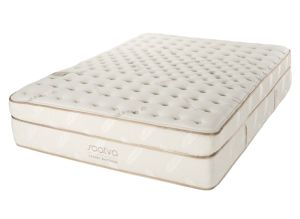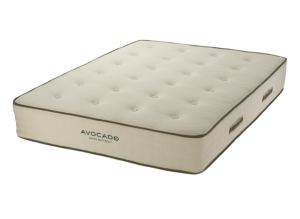What Is the Best Eco-Friendly Mattress?
Saatva Latex Hybrid →
Its materials are all handcrafted and sourced in the United States, focusing on durability, sustainability, and quality. Saatva prides itself on its customer service. Friendly representatives are available via phone and on their website, 24 hours a day should you have questions or problems. Saatva offers a 180-night trial period for all of their products and a 15-year warranty.
- ✔15-year warranty
- ✔Available in Plush Soft, Luxury Firm, and Firm
- ✔Eco-friendly materials
- ✔Handcrafted in the US
- ✔180-day home trial. Full refund available
- ✔Free white glove delivery & mattress removal
Avocado Green →
This hybrid model mattress is actually more on the soft side than we expected. The coils used inside the latex memory foam are dispersed around 5 separate ergonomic zones to provide a very supportive sleeping experience. This helps to alleviate pressure points, align the spine, and relieve lower back pain.
- ✔Handcrafted in CA, USA
- ✔Eco-friendly materials
- ✔Ethically sourced
- ✔100% free of toxic chemicals
- ✔25-year warranty
- ✔Free carbon neutral shipping
Birch Natural →
Birch is the environmentally-conscious subsidiary of sleep giant Helix. Their only mattress, called simply the “Birch Natural Mattress,” is billed as one of the most sustainable and ethical beds on the market today.
- ✔Environmentally friendly
- ✔Sturdier and more supportive than most hybrid models
- ✔Strong edge support
- ✔Extremely breathable and cooling
- ✔Made in USA
- ✔Free Shipping and Returns
Overview
Now that many people are more conscious of their carbon footprints, many consumers elect to purchase products that are organic, eco-friendly, and chemical and toxin-free. This same eco-friendly consumer demand is also ringing true with mattresses; people today do not want to sleep on something that will harm the environment, harm them, or both. When trying to shop “green” for mattresses, certifications such as CertiPUR or OEKO-TEX Standard 100 indicate that it is considered to have low human health risks; no one wants to sleep on something that poses a risk to their health. The Global Organic Textile Standard (GOTS) and GreenGuard are some other important certifications; these indicate that the materials used in production have a low environmental impact. Unfortunately, there is a large amount of “greenwashing” that goes on with mattress advertisements; this is when brands market their product as more “green” than they actually are by using misleading language. Of course, this gets the retailer more business, but can be confusing for most consumers; how do you know which are truly eco-friendly and which are not? We’re here to help you find an environmentally friendly mattress that is good for both you and the world we live in. You can sleep comfortably knowing you are doing your part to leave the world better than you found it. Bonus: you will also sleep well because you will be in your new, comfortable, eco-friendly bed.What Makes a Bed Eco-Friendly?
Green technology has certainly advanced in recent years, in nearly all products: cars, dishware, clothing, cosmetic supplies, and now mattresses, too. A truly eco-friendly mattress will include organic and/or natural materials in the core, comfort layers, and cover. Materials like natural latex, plant-based polyfoam or memory foam, organic cotton or wool in the mattress cover, and fire-resistant socks in memory foam beds that are made of wool, cotton, thistle, or Kevlar. Although there are ample eco-friendly materials available, it is worth noting that mattresses can never be 100% natural and/or organic; 60-95% is the standard for “green” mattresses. And that’s certainly better than nothing. You can also purchase a “half-organic” or “half-natural” mattress made with some eco-friendly materials; this can help with the budget, but these mattresses are not truly green as they do not meet the 60% standard. So with all of these choices, how do you determine which natural mattress is right for you?Green Certifications
There are many certifications that can help tell the difference between a true eco-friendly mattress and the other mattresses on the market. These certifications are broken into two general groups: certifications that focus on human health and certifications that focus on environmental impact. Some of the certifications that focus on human health are the OEKO-TEX Standard 100, CertiPUR-US, and Eco-Institut. These certifications are usually used to test the mattress materials, such as foam or latex, for harmful chemicals, dyes that trigger allergies, and other harmful substances such as lead. The list of environmental certifications is more extensive. Some of these certifications are:- Global Organic Textile Standard (GOTS)
- Global Organic Latex Standard (GOLS)
- GreenGuard/GreenGuard Gold
- United States Department of Agriculture (USDA)
- Organic/National Organic Program (NOP)
- OEKO-TEX MADE IN GREEN
- Cradle to Cradle
- The Global Recycled Standard
- Rainforest Alliance Certified
Pros and Cons
As with any major purchase, there are some pros and cons to an eco-friendly mattress. In this particular case, there are many more pros than cons. One main con to buying a green mattress is the price point due to the materials, especially if the mattresses have organic certifications. There is also an overall smaller selection as opposed to typical non-green mattresses. The long list of pros includes potential health benefits, since you are sleeping on a surface that is free of chemicals that could be harmful to your health. These eco-friendly mattresses also tend to have a longer life span due to quality materials, which is a wonderful pro for such a large investment. Also due to the materials used in production, such as naturally breathable cotton or wool, or aerated latex, you will likely sleep much cooler on an eco-friendly mattress. Then there is the obvious pro of reducing your environmental impact by buying a bed made with products that do not harm the environment.What Types of Mattresses Can Be Eco-Friendly?
- Innerspring – Innerspring mattresses get their name from the springs used in the support core, and they usually have some foam in the comfort layers, though anything more than two inches is technically considered a hybrid mattress. Innerspring mattresses can be labeled as “green” and the coils can be produced sustainably, but, for some of them, this is not always the case, as some of these mattresses are typically produced in non-green, industrial ways.
- Hybrid – Hybrid mattresses are a comfortable combination of innerspring and foam mattresses; similar to innerspring mattresses, not all of these are truly green. However, the comfort layers of foam may be produced with organic materials, and some may utilize recycled steel for their pocketed coils.
- Latex – Latex mattresses are the mattresses most commonly marketed as “green” because latex is a natural product made from rubber trees. Latex is manufactured in one of two ways, either the Dunlop process or the Talalay process. Unfortunately with latex mattresses, greenwashing is a common problem; they may be marketed as “100% Organic” or “100% Natural,” but that is not always completely true as a small number of chemical components are necessary to create latex foam. However, if you’re in search of the most natural mattress you can find, a mattress with natural latex and a GOLS certification (which evaluates the raw materials used) is the way to go!
- Foam – Foam mattresses are broken down into two main categories: Standard Polyurethane foam (polyfoam) and Viscoelastic Polyurethane (memory foam) foam. The polyfoam is not treated with chemicals for softness or temperature response and is usually found in support cores, but can be in comfort layers as well; these mattresses have a lower price point and a shorter lifespan. On the other hand, memory foam is treated with petrochemicals for enhanced softness. Any mattresses with polyurethane are not eligible for GOLS or GOTS certifications, though they are of course tested for human safety. Plant-based memory foam beds are a wonderful chemical-free alternative; the foam is produced utilizing plant-based oils as opposed to petroleum and other chemicals.
Mattress Shopping
Once you settle on what type you want, what kind of eco-friendly certifications you want, and gain knowledge about common greenwashing marketing, it is time to decide your own needs as an individual sleeper or a couple. When shopping, there are many important points to keep in mind, but arguably the most important is firmness. Firmness is not important simply for comfort, but for your spinal health. If you are a stomach sleeper or back sleeper, you might need a one on the more firm end, and if you are a side sleeper, you can likely still feel supported on something softer. Your body weight is an important factor when deciding suitable firmness levels; if you are a heavier sleeper (over 230 pounds), you need a firmer mattress for optimal spinal support, and if you are a lighter sleeper (under 130 pounds), you may not feel comfortable on a firm mattress and can get adequate support with a softer one. Aside from firmness levels, looking at the retailer’s individual policies may also be important for you. A few things to consider are warranties, sleep trials, and delivery processes. Some companies offer sleep trials, so you can feel certain of your investment in your mattress. Others offer extended warranties to give you peace of mind. Very few will deliver your new mattress, set it up, and take your old one away. It is important to read all of these policies so you can decide what is necessary for you. A mattress is a big investment and you deserve to feel secure in that investment.Pillows and Bedding
Mattresses are not the only sleep item going green! Natural and/or organic sheets, pillows, and mattress toppers are also available. Some materials that may be found in these items are:- wool
- cotton
- kapok
- latex
- buckwheat






